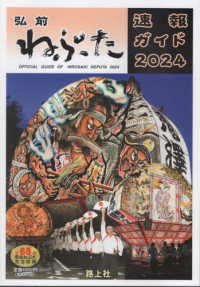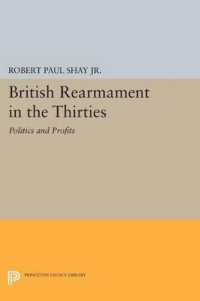- ホーム
- > 洋書
- > 英文書
- > Cinema / Film
Full Description
Alfred Hitchcock's imperative was to charge the screen with emotion. Subject matter and acting were, for him, subordinate to "all of the technical aspects that made the audience scream." Focusing on onscreen objects in Hitchcock's films, this study examines staircases, eyeglasses, lamps, doors, candles, cigarettes, buildings, monuments, statues and dozens of other props that the director treated as subjective protagonists, their roles nearly equal to the actors'. Examining each of the director's 52 extant films, this book provides a comprehensive exploration of Hitchcock's treatment of objects as subjects.
Contents
Table of Contents
Preface
Introduction
The Pleasure Garden (1925)
The Lodger: A Story of the London Fog (1927)
Downhill (1927)
Easy Virtue (1927)
The Ring (1927)
The Farmer's Wife (1928)
Champagne (1928)
The Manxman (1929)
Blackmail (1929)
Juno and the Paycock (1930)
Murder! (1930)
The Skin Game (1931)
Rich and Strange (1932)
Number Seventeen (1932)
Waltzes from Vienna (1933)
The Man Who Knew Too Much (1934)
The 39 Steps (1935)
Secret Agent (1936)
Sabotage (1936)
Young and Innocent (1937)
The Lady Vanishes (1938)
Jamaica Inn (1939)
Rebecca (1940)
Foreign Correspondent (1940)
Mr. and Mrs. Smith (1941)
Suspicion (1941)
Saboteur (1942)
Shadow of a Doubt (1943)
Lifeboat (1944)
Spellbound (1945)
Notorious (1946)
The Paradine Case (1947)
Rope (1948)
Under Capricorn (1949)
Stage Fright (1950)
Strangers on a Train (1951)
I Confess (1952)
Dial M for Murder (1954)
Rear Window (1954)
To Catch a Thief (1955)
The Trouble with Harry (1955)
The Man Who Knew Too Much (1956)
The Wrong Man (1957)
Vertigo (1958)
North by Northwest (1959)
Psycho (1960)
The Birds (1963)
Marnie (1964)
Torn Curtain (1966)
Topaz (1969)
Frenzy (1972)
Family Plot (1976)
Conclusion
Bibliography
Index







